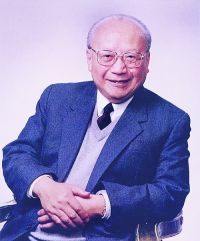Difference between revisions of "Qian Weichang"
imported>Conan (Created page with 'thumb|200px|right '''Qian Weichang''' (Chinese:钱伟长)(also known as Chien Wei-zang) was a well-known scientist in applied mathematics, mechanics ...') |
imported>Conan |
||
| Line 1: | Line 1: | ||
[[File:Qian Weichang.jpg|thumb|200px|right]] | [[File:Qian Weichang.jpg|thumb|200px|right]] | ||
| − | '''Qian Weichang''' (Chinese: | + | '''Qian Weichang''' (Chinese:钱伟长)(also known as Chien Wei-zang) was a well-known scientist in applied mathematics, mechanics and physics. |
He was born on Oct. 9, 1913 in Wuxi, [[Jiangsu Province]], and graduated from physics department of [[Tsinghua University]], [[Beijing]], with B.S. in 1935. He studied as a post-graduate student in the applied mathematics department at the University of Toronto, Canada, and obtained an M.A. degree in 1941, and Ph.D. in 1942. | He was born on Oct. 9, 1913 in Wuxi, [[Jiangsu Province]], and graduated from physics department of [[Tsinghua University]], [[Beijing]], with B.S. in 1935. He studied as a post-graduate student in the applied mathematics department at the University of Toronto, Canada, and obtained an M.A. degree in 1941, and Ph.D. in 1942. | ||
Latest revision as of 10:16, 30 July 2010
Qian Weichang (Chinese:钱伟长)(also known as Chien Wei-zang) was a well-known scientist in applied mathematics, mechanics and physics.
He was born on Oct. 9, 1913 in Wuxi, Jiangsu Province, and graduated from physics department of Tsinghua University, Beijing, with B.S. in 1935. He studied as a post-graduate student in the applied mathematics department at the University of Toronto, Canada, and obtained an M.A. degree in 1941, and Ph.D. in 1942.
His academic achievements could be called amazing and inspiring, as Qian had almost no knowledge of physics when he entered Tsinghua University as a history major. In the wake of the September 18 incident in 1931, Qian decided to give up history and learn physics in hope of making advanced weapons to defeat the Japanese invaders.
After graduation, he worked as research engineer in a jet propulsion laboratory at the California Institute of Technology, Pasadena, California from 1942-1946. He was professor, dean and vice president at Tsinghua University from 1946-1982, president of Shanghai University of Technology from 1982-1994, and president of Shanghai University from 1994-2010. He was also the vice director of Institute of Mechanics(1955-1958), director of Institute of Automation (1956-1958) and Shanghai Institute of Applied Mathematics and Mechanics(1984-2010), a member of Academia Sinica (1954-2010), and a member of the Polish Academy of Science (1955-2010).
Qian’s scientific works from 1935-1997 covered a large number of important areas in applied mathematics. He made outstanding contributions on the intrinsic theory of plates and shells, large deflection theory of plates and shells, and their perturbation method and singular perturbation method of solutions, generalized variational principles, analytical solution of ring-shell, and Chinese computer codes.
His first paper on the intrinsic theory of shells and plates was published in collaboration with J.L. Synge in von Karman Anniversary volume in 1940, and a series of papers published by Qian on the same problem attracted wide interest from 1940-1970, especially the nonlinear equations for the treatment of nonlinear stability problems of shallow shells. In 1960-1970, these equations were named Chien’s (Qian’s) equation for nonlinear stability of shallow shells.
In 1948, a new parametric perturbation theory was suggested to solve the von Karman large deflection problem. This method can be used to solve many other difficult nonlinear problems. The method was named Chien’s (Qian’s) method in Soviet literature. His works on generalized variational principle (1970-1990) were useful to simplify the finite-element calculations. Qian successfully suggested using the method of Lagrange multiplier for eliminating the constraint conditions of all kinds of variational problems, and thus established a new variational functional, finally changing the max.-min. ordinary variational problems with constraint conditions into stationary generalized variational problems with no constraint conditions or less conditions. This method can be used to solve many variational problems in solid mechanics, fluid mechanics, heat conduction, and electromagnetic field problems.
From 1990, Qian developed a new field of non-Kirchhoff-Love theory of plates and shells. This work can be used for solving the problems of thick plates and shells and is important for the design of high-pressure containers and heavy machinery.
Qian died on July 30, 2010, at the age of 98.
